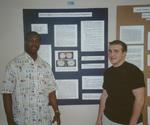 Beubrun, R. C., J. A. DeBonza, E. C. Morse, S. E. Wise, and B. W. Buchanan. 2002.
Beubrun, R. C., J. A. DeBonza, E. C. Morse, S. E. Wise, and B. W. Buchanan. 2002.
Factors influencing sound production in red-backed salamanders.
ABSTRACT:
Red-backed salamanders, Plethodon cinereus, have been shown to use chemical and visual signals for communication. Salamanders also produce sounds (clicks) that have an unknown function. Our goal is to determine what factors lead to sound production in P. cinereus. We hypothesized that the total number of clicks produced by salamanders would be influenced by disturbance. We tested thirty animals under each of three treatments: unhandled, handled, and novel environment. The handled treatment involved removing and immediately replacing a salamander back into its residence (Petri dish). The novel treatment is the same as the handled treatment except the salamander was placed into a new Petri dish. The unhandled treatment served as a control in which the animal remained in its Petri dish without being handled. After manipulation (handling, not handling, or moving a salamander to a novel environment), the lid was replaced with one that had a 10.7 cm diameter hole, leaving a lip of approximately 1.7 cm to prevent escape. The opening was necessary to allow observers to hear the barely audible clicks. Following a two-minute habituation period, we recorded the number of clicks for ten minutes. We compared the number of clicks produced by salamanders in each of the three treatments using a two-tailed Friedman?s test ( a =0.05), followed by Tukey-type multiple comparisons. We found that salamanders produced significantly more clicks under the handled treatment than under the novel environment or control treatment. Thus, clicking in salamanders appears to be a response to handling but not to all forms of disturbance.
 Beubrun, R. C., J. A. DeBonza, E. C. Morse, S. E. Wise, and B. W. Buchanan. 2002.
Beubrun, R. C., J. A. DeBonza, E. C. Morse, S. E. Wise, and B. W. Buchanan. 2002.
 Beubrun, R. C., J. A. DeBonza, E. C. Morse, S. E. Wise, and B. W. Buchanan. 2002.
Beubrun, R. C., J. A. DeBonza, E. C. Morse, S. E. Wise, and B. W. Buchanan. 2002.